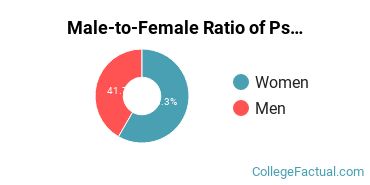 by our College Data Analytics Team
by our College Data Analytics TeamThe main focus area for this major is General Psychology. For more details on this concentration, visit its profile page.
General Psychology is a major offered under the psychology program of study at Colorado State University - Fort Collins. Here, you’ll find out more about the major doctor’s degree program in psychology, including such details as the number of graduates, diversity of students, and more.
If there’s something special you’re looking for, you can use one of the links below to find it:
In 2019-2020, the average part-time graduate tuition at Colorado State was $1,433 per credit hour for out-of-state students. The average for in-state students was $584 per credit hour. Information about average full-time graduate student tuition and fees is shown in the table below.
| In State | Out of State | |
|---|---|---|
| Tuition | $10,520 | $25,791 |
| Fees | $2,264 | $2,264 |
The median early career salary of psychology students who receive their doctor’s degree from Colorado State is $59,124 per year. That is 7% lower than the national average of $63,491.

Online degrees for the Colorado State psychology doctor’s degree program are not available at this time. To see if the school offers distance learning options in other areas, visit the Colorado State Online Learning page.
About 70.0% of the students who received their Doctorate in psychology in 2019-2020 were women. This is about the same as the countrywide number of 71.1%.

None of the psychology doctor’s degree recipients at Colorado State in 2019-2020 were awarded to racial-ethnic minorities*.

| Race/Ethnicity | Number of Students |
|---|---|
| Asian | 0 |
| Black or African American | 0 |
| Hispanic or Latino | 0 |
| Native American or Alaska Native | 0 |
| Native Hawaiian or Pacific Islander | 0 |
| White | 9 |
| International Students | 0 |
| Other Races/Ethnicities | 1 |
General Psychology students may decide to major in one of the following focus areas.
| Focus Area | Annual Graduates |
|---|---|
| General Psychology | 10 |
*The racial-ethnic minorities count is calculated by taking the total number of students and subtracting white students, international students, and students whose race/ethnicity was unknown. This number is then divided by the total number of students at the school to obtain the racial-ethnic minorities percentage.
More about our data sources and methodologies.